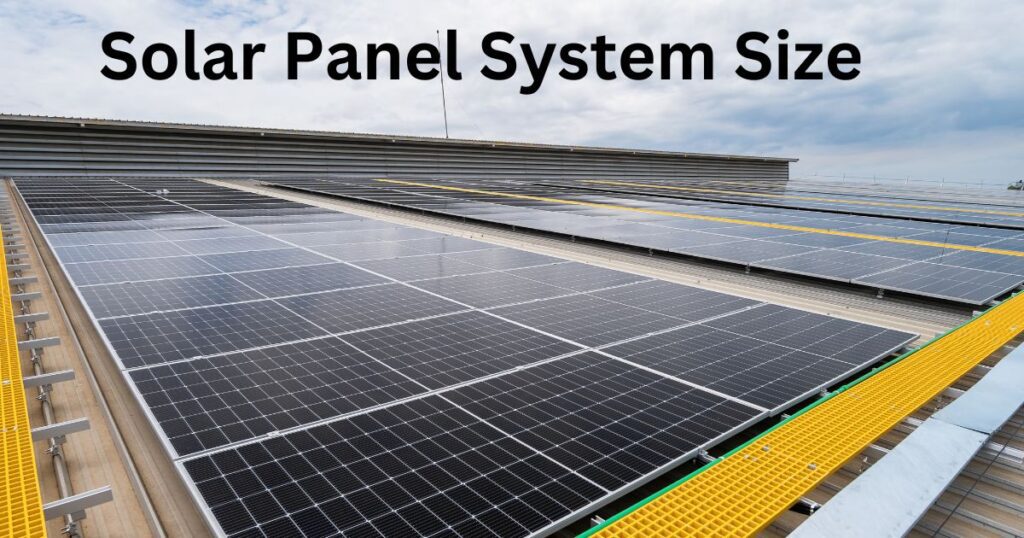Last updated on March 5th, 2025 at 03:11 am
The size of solar panel systems doesn’t mean the physical size of the solar panels; rather, it focuses on the capacity or output of the solar panels in terms of energy production to power your home or business. Having an idea about the size of your solar panel system is the first stepping stone towards your journey to renewable energy.
In this comprehensive article, we commit to demystifying the complexities surrounding solar panel sizing. Whether for your home or business, we’ll provide insights on calculating the optimal number of solar panels, considering variables such as energy consumption, peak sunlight hours, and wattage of your solar panels. By the end, you’ll possess a clear roadmap to a solar solution tailored precisely to your needs, ensuring a sustainable and efficient energy future.
1. Understanding your energy consumption is the first step to calculate the size of solar panel systems
2. Wattage of the solar panels and peak sunlight hours in your area is the most important factors to calculate the size of solar panel systems
3. Solar panel suffers up to 24% energy losses due to solar cell technology, system design and maintenance
Solar Panel System Size Calculator
(*) Required field
Important factors to consider to calculate size of solar panel systems
Understanding your energy needs
Solar panel efficiency and wattage
Solar panel efficiency refers to the percentage of sunlight that a solar panel can convert into electricity. For example, a solar panel with 20% efficiency converts 20% of the sunlight it receives into electrical power.
On the other hand, the wattage of a solar panel represents the maximum amount of power it can produce under standard test conditions. Solar panel efficiency is proportional to the wattage of the solar panels, it means high efficiency solar panels have higher wattage. Commonly, solar panels for residential use have wattages ranging from 250W to 400W per panel.
Solar irradiance and its impact on solar energy generation
Solar irradiance refers to the amount of sunlight energy received per unit area. It is a crucial factor in determining the energy output of a solar panel system. Measured in kilowatt-hours per square meter per day (kWh/m²/day), solar irradiance varies based on factors such as time of day, season, and geographical location.
Solar panel efficiency is influenced by the intensity of sunlight. Higher solar irradiance generally leads to higher efficiency because more sunlight is available to be converted into electricity. Solar panels are designed to perform optimally under specific irradiance conditions. In regions with high solar irradiance, panels can generate more power per unit area compared to regions with lower irradiance.

Peak sunlight hours
Peak sunlight hours, also known as solar peak hours or peak sun hours, refer to the specific period during the day when sunlight intensity is at its maximum. It’s important to note that peak sunlight hours are not equivalent to the total number of daylight hours in a day.
During peak sunlight hours, the sun is positioned at its highest point in the sky, and its rays are more direct, resulting in higher solar irradiance. Solar panels are most efficient in converting sunlight into electricity during these peak hours.
The exact duration of peak sunlight hours varies based on factors such as geographic location, time of year, and local weather conditions. In locations closer to the equator, where the sun’s angle is more direct throughout the year, peak sunlight hours may be more consistent. In contrast, regions at higher latitudes or experiencing significant seasonal variations may have varying durations of peak sunlight hours.
In the Unites States, New Mexico, Arizona, and Nevada experience the highest peak sun hours, averaging more than 6 hours. On the other hand, Alaska, Washington, and Illinois have the lowest peak sun hours, with an average of 3 hours.
Solar panel losses
Solar panel energy losses refer to the reduction in the efficiency and output of a solar power system due to various factors that can diminish the amount of sunlight converted into usable electrical energy. Understanding these losses is crucial for optimizing the performance of solar panel installations. Solar panels exhibits up to 24% annual losses of its total power production.
Systems with annual energy losses between 10% and 15% are still considered to be in excellent working condition. Solar panel systems with annual energy losses between 15% and 25% are generally considered to be satisfactory. While there is room for improvement, the system is still providing a significant amount of solar energy.
Solar panel losses result from several factors, including irradiation, thermal losses, reflection, and array mismatch, all inherent to the technology. Environmental factors like dust, dirt, and shading further impact efficiency. Additionally, system-related issues, such as DC cable and inverter losses, contribute to overall energy loss.
Formula to calculate size of solar panel systems
The size of your solar panel system is
= Number of solar panels you need ×Wattage of the solar panel
Lets breakdown the calculation:
Lets consider:
Your average energy consumption per year is, 10,800 kWh and monthly energy consumption is 900 kWh
Wattage of your solar panel is : 350 W or 0.35 kW.
Average peak sunlight hours in your area is : 6.
Annual solar panel energy loss is : 24%
Number of solar panels you need = [Your monthly energy consumption (900 kWh) × Solar panel energy loss (1.24)]/ [Wattage of the solar panel (0.35 W) × Peak sun hours (6h)× 30]
You need 17.71 or 18 solar panels to fulfil your monthly energy consumption of 900 kWh.
Size of your solar panel system is=Number of solar panels you need ×Wattage of the solar panel=18×350 W=6.3 kW
For your convenience, use the calculator Click here to determine number of solar panels you need.
Final words!
The size of a solar panel system depends on various factors, including energy consumption needs, available space, and budget constraints. Optimal system sizing involves a balance between meeting energy demands and maximizing efficiency. Assessing current and future energy needs, considering local sunlight conditions, and understanding technological advancements are crucial for making informed decisions about the size of solar panel systems.
Frequently Asked Questions (FAQs)


